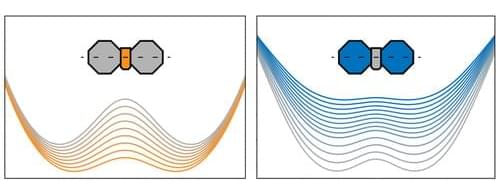An extremely precise detection method for single electrons, which pins down the particles with a resolution of trillionths of a second, may provide a valuable building block for future quantum technologies



Just as overlapping ripples on a pond can amplify or cancel each other out, waves of many kinds — including light, sound and atomic vibrations — can interfere with one another. At the quantum level, this kind of interference powers high-precision sensors and could be harnessed for quantum computing.
In a new study published in Science Advances, researchers at Rice University and collaborators have demonstrated a strong form of interference between phonons — the vibrations in a material’s structure that constitute the tiniest units, or quanta, of heat or sound in that system. The phenomenon where two phonons with different frequency distributions interfere with each other, known as Fano resonance, was two orders of magnitude greater than any previously reported.
“While this phenomenon is well-studied for particles like electrons and photons, interference between phonons has been much less explored,” said Kunyan Zhang, a former postdoctoral researcher at Rice and first author on the study. “That is a missed opportunity, since phonons can maintain their wave behavior for a long time, making them promising for stable, high-performance devices.”
Rice researchers have demonstrated a form of quantum interference two orders of magnitude greater than any previously reported.


In a new study published in Nature Physics, scientists have achieved the first experimental observation of phonon angular momentum in chiral crystals.
Phonons are the quantized lattice vibrations representing sound and heat in crystals. Theoretically, phonons have been predicted to carry finite angular momentum with potentially remarkable macroscopic consequences.
The famous Einstein-de Haas effect explains how quantum mechanical spin connects to classical angular momentum when a ferromagnetic cylinder rotates under magnetic fields. While this effect has been known for over a century, the phonon version had remained purely theoretical until now.

In everyday life, continuously doing work on a system is found to heat it up. Rubbing your hands together warms them. Hammering a piece of metal makes it hot. Even without knowing the equations, we learn from experience: driving any system, whether by stirring, pressing, or striking, leads to a rise in the system’s temperature.
The same expectation holds for microscopic quantum systems: when we continuously excite a many-particle system, especially one with strong particle-particle interactions, we expect it to absorb energy and to heat up. But is this always the case, in particular at the quantum level?
No, says an experiment carried out by a team from Hanns-Christoph Nägerl’s group at the Department of Experimental Physics of the University of Innsbruck. The research has been published in Science.


Learn More About Anydesk: https://anydesk.com/spacetime.
In 1987, Steven Weinberg wrote a cute little paper entitled “Anthropic Bound on the Cosmological Constant”. I say cute little paper because it feels minor in comparison to, say, electroweak unification theory that won him the Nobel Prize. Weinberg was foundational in establishing the standard model of particle physics, and represented an enormous leap in understanding how this universe works. But his little 1987 paper, though more obscure, may tell us something about how the multiverse works, and can even be thought of as evidence for the existence of an enormous number of other universes.
PBS Member Stations rely on viewers like you. To support your local station, go to: http://to.pbs.org/DonateSPACE
Sign Up on Patreon to get access to the Space Time Discord!
https://www.patreon.com/pbsspacetime.
Check out the Space Time Merch Store.
https://www.pbsspacetime.com/shop.
Sign up for the mailing list to get episode notifications and hear special announcements!

Chinese researchers unveil 10x larger atom array for next-gen quantum processors.
Scientists in China have achieved a significant breakthrough in advancing quantum physics.
A team of researchers has developed the largest array of atoms for quantum computing.
The key component for a quantum computer is reportedly capable of creating arrays 10 times larger than previous systems.
Head to https://squarespace.com/territory to save 10% off your first purchase of a website or domain using code TERRITORY
Become a member today:
/ @territoryspace.
Some scientists now propose that our universe might have been born inside a massive black hole within a larger parent cosmos. In their model, the universe before ours followed the same laws of physics we know today, expanding for billions of years before gravity overcame that outward push. Space began to contract, galaxies moved closer, and the cosmos collapsed toward extreme densities. Instead of ending in a singularity where physics breaks down, quantum effects pushed back against gravity, halting the collapse and triggering a cosmic rebound. That bounce could have launched our own universe’s expansion, making the Big Bang not the true beginning, but a continuation.
This idea draws on the Pauli Exclusion Principle and degeneracy pressure, which in smaller-scale examples prevent white dwarfs and neutron stars from collapsing indefinitely. The same resistance, applied on a universe-wide scale, could stop total collapse inside a black hole. Simulations suggest such a process could occur without invoking exotic new particles or forces. In this framework, the formation of our universe is a purely gravitational event, governed by the physics we already understand, just operating under extreme conditions beyond what we have directly observed.
One striking prediction is that ancient relics from the parent universe could have survived the bounce. These might include primordial black holes or neutron stars that predate our own cosmos. If detected, especially in the early universe, they could serve as evidence that a cosmic bounce occurred. The James Webb Space Telescope’s discovery of unexpectedly massive galaxies soon after the Big Bang could align with this idea, as such galaxies may have formed more easily if early black holes were already present to seed them.
Recent JWST findings on how galaxies spin across the universe may also fit the model. If confirmed, these patterns could point toward a shared origin and support the possibility that we live inside a black hole. While the concept remains controversial, it offers a potential bridge between general relativity and quantum mechanics, challenging the assumption that singularities are inevitable and suggesting that the life cycle of universes may be far more connected than we thought.